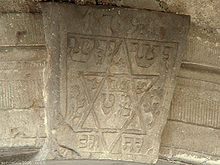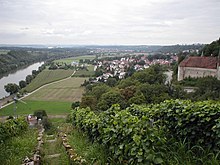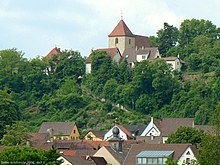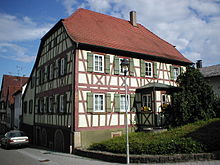Heinsheim
|
Heinsheim
City of Bad Rappenau
|
|
|---|---|
| Coordinates: 49 ° 15 ′ 44 " N , 9 ° 8 ′ 58" E | |
| Height : | 154 m |
| Area : | 6.29 km² |
| Residents : | 1593 (Oct. 1, 2018) |
| Population density : | 253 inhabitants / km² |
| Incorporation : | March 1, 1972 |
| Postal code : | 74906 |
| Area code : | 07264 |
Heinsheim is a village in Baden-Württemberg in the Kraichgau . It has been a district of Bad Rappenau since 1972 .
geography
Heinsheim is located on the eastern edge of the Kraichgau between Bad Wimpfen and Gundelsheim on the left slope of the Neckar Valley , approx. 4 km northeast of the main town Bad Rappenau above.
history
Local history
The oldest human finds from Heinsheim are simple tools from the younger Paleolithic , they are around 40,000 years old. The first settlement of Heinsheim probably took place at the time of the Romans, who had the border of their empire on the Neckar between the years 100 and 260 AD, the so-called Neckarlimes . According to tradition, a stone idol from this period is said to have been kept in the castle. The foundations of a Roman manor are located in the municipality, which was destroyed after the Romans left. There is evidence of continuous settlement since the time of the Celts, from which a (today overbuilt) grave from the pre-Christian Iron Age (around 400 BC) was preserved in the Gewann Seegarten . During the excavations, a Franconian cemetery from the 7th century with a total of six graves was discovered in the immediate vicinity.
In a document, presumably from the year 965, the place is mentioned for the first time as Heinesheim ("Heim des Hein (o)"). A parish church is also mentioned there. The diocese of Worms became feudal lord over the place in 976 , and until the end of the 12th century secular jurisdiction lay with the Tenth Court in Wimpfen .
Heinsheim is particularly known for the Ehrenberg Castle on Burgenstrasse , which probably dates back to the 12th century . From the 13th to the 17th century, the lords of Ehrenberg were patrons of the place. The ruins of the massive keep from 1235 are around 50 meters high and are said to have been even higher in the past. The castle chapel St. Alban from 1602 belongs to the castle. The strong damage to the castle is said to have resulted from the Thirty Years War .
In 1418 a third of the property in Heinsheim went to the Commandery of the Teutonic Order in Horneck Castle near Gundelsheim. The order remained Catholic during the Reformation , while the local rulers were reformist-minded. A first Reformation-minded pastor, Laurentius Hügel from the collegiate monastery of St. Petri in Wimpfen, was expelled in 1529 at the instigation of the order. In the village regulations of 1537, the village lords agreed not to exert any pressure on the residents in matters of faith, which was confirmed again in the village regulations of 1558. After 1529, mainly Reformation-minded pastors worked in the village, and from 1560 to 1570 another Catholic clergyman, Martin Kuch, officiated. In the late 16th century and in the period after 1600, the Teutonic Order tried again massively, but ultimately unsuccessfully, to obtain the appointment of a Catholic clergyman. In 1624 the whole place was Protestant. In the course of the Thirty Years War there were renewed attempts at recatholization, but ultimately after the Peace of Westphalia the religious status of 1624 was decisive, so that the mountain church has belonged to the Protestant parish since then, while the Catholics used the castle chapel from 1655 and in the 19th century they had their own Church built.
There is evidence of a town hall in Heinsheim since 1539.
The Lords of Ehrenberg died out with Hans Heinrich von Ehrenberg in 1647. Their property on site fell back to the diocese of Worms and, due to an exchange of goods in 1637, partly to the Lords of Helmstatt . The Ehrenberg coat of arms remained as the local coat of arms. From 1727, the Barons von Racknitz , who came from Styria, built the castle in Heinsheim. In 1803 the Landgrave of Hesse became the legal successor to the Worms monastery. From him the Racknitz also acquired the castle and half of Zimmerhof in 1805 . While the castle was extended by Carl Freiherr von Racknitz (1785–1868) from 1810 with a park-like garden and is still maintained today, only a few residential buildings from the 17th and 18th centuries in the outer bailey were restored from the ruined castle complex.
In 1806 Heinsheim came to Baden as an independent village. From 1825 to 1868 there was a port on the Neckar below Ehrenberg Castle on the road to Neckarmühlbach. The port called Lauer was mainly used to transport salt from the Rappenau salt works to Mannheim and Karlsruhe. The port was also the end point of the salt road leading from Richen via Kirchardt and Rappenau to Heinsheim . With the construction of the railway line to Meckesheim, shipping was slowly stopped. After the lock in Gundelsheim was built in 1935, the landing stages finally silted up in the river.
The place was dominated by agriculture until the recent past. In 1935 Zimmerhof was incorporated into Heinsheim. In 1939 there were 794 inhabitants, at the end of 1945 there were 962. On April 1, 1950 Zimmerhof became a district of Bad Rappenau. Heinsheim still belonged to the district of Mosbach .
On March 1, 1972, Heinsheim was incorporated into Bad Rappenau and thus became part of the Heilbronn district . When it was incorporated in 1972, Heinsheim had 1512 inhabitants, and in June 2004 there were 1642 inhabitants.
Jewish community

The Jewish community of Heinsheim came into being when the Teutonic Order and the aristocratic local lords settled Jews from the 16th century, who built the large Heinsheim Jewish cemetery outside the town in Gewann Schlierbach , which was later used as a place of burial by up to 25 surrounding Jewish communities. From the 16th century onwards there was always a Jewish school in Heinsheim, which was also attended by the Jews from Wimpfen , with whom there were close relationships. The building of the Heinsheim synagogue, which is still preserved today, dates from 1796. According to a review from 1681, the Jewish community in Heinsheim was initially limited to nine families (three families under the protection of the Teutonic Order, six families under the protection of the local authorities), but grew In 1767 it was based on 17 families and around 110 people by the middle of the 19th century. After that, the size of the community fell sharply due to emigration and emigration. In 1900 there were still 82 Jews counted, in 1933 24, 16 of whom emigrated by 1937, after which the community was dissolved and the synagogue and ritual bath were sold. In November 1938 there were riots against five Jewish households. In 1940 there was still a Jewish family living in Heinsheim, which was deported to Camp de Gurs and then partially died. There were also three victims among the Jews who moved after 1933. Before 1945 there were plans to level the Jewish cemetery and use it for agriculture. However, a sales contract signed with the municipality of Heinsheim in 1944 was no longer entered in the land register, and the cemetery was retained.
The descendants of Heinsheim Jews are:
- Fritz Heinsheimer (1897–1958), German expressionist, later realistic painter
- Hans Heinsheimer (1900–1993), Austrian music publisher, author and journalist
- Karl Heinsheimer (1869–1929), German civil lawyer and professor at Heidelberg University
- Max Heinsheimer (1832-1892), legal scholar and higher regional judge from Baden
coat of arms
The blazon reads: In silver, the large feathers swiveling downwards, a red eagle wing covered with a golden moon, which is closed at the front with an eagle's head turned to the left and at the back with a clover leaf.
The coat of arms is derived from the coat of arms of the former local rule, the Lords of Ehrenberg .
Attractions
- Ehrenberg Castle dates from the 12th century, the outer bailey was built in the 17th and 18th centuries. Century erected. The St. Alban's castle chapel (built in 1602) was redesigned in the baroque style in 1776.
- Heinsheim Castle (1725) with castle chapel (first mentioned in 1621)
- The Heinsheimer Bergkirche was mentioned as early as the 10th century. In the choir it has a Gothic cross vault with medieval paintings, as well as several grave monuments from those of Ehrenberg. At the church is a dry stone wall with fragments of historical tombstones and the grave of the Barons von Racknitz. The ancient fountain, probably an old baptismal font, was last redesigned together with the fountain house in 1898.
Gothic cross vault in the mountain church
- The town center is rich in historical buildings. The half-timbered houses of the 18th century are often built on older foundations. Many buildings date back to the 16th century, but were often structurally redesigned in the past as required. The former synagogue in Heinsheim from 1796 was sold in 1938 by the then Jewish community to a farmer from Heinsheim, who initially used it as a barn and thus saved it from being destroyed by the National Socialists. A workshop and forge was operated there until 2012. Since July 2012, the building has been owned by the Freundeskreis former Synagoge Heinsheim eV, which is currently extensively restoring the building and using it for cultural events and as an interreligious meeting place. The town hall is a modern, functional building on the site of older predecessor buildings mentioned in 1536.
Former synagogue (1792)
Half-timbered house near the town hall (1705)
- The Catholic Church of St. John the Baptist from 1838 is the youngest sacred building in Heinsheim. In the nearby cemetery there is a war memorial for the “victorious heroes” in 1870/71.
- Outside the village, on the ridge between the Neckar and Fünfmühlental, is the Heinsheim Jewish cemetery, which was laid out in the 16th century and has almost 1200 historical gravestones.
" War memorial "
Vaulted cellar Gundelsheimer Strasse (16th century)
traffic
The place once had a stop on the Neckar Valley Railway Heidelberg – Heilbronn.
Sports
The sports club TSV Heinsheim, founded in 1911, was in the first division of the weightlifting division from 2002 to 2006, but found itself back in the second division after the leagues were restructured. In 2006 and 2011 the European Masters Championship was held in Heinsheim . In 2011 TSV Heinsheim celebrated its 100th anniversary.
literature
- Gustav Neuwirth: History of the village of Heinsheim a. N. , Heinsheim 1954 (and 2nd revised edition 1965)
- Gustav Neuwirth: History of the City of Bad Rappenau . City of Bad Rappenau, Bad Rappenau 1978
- Jewish life in the Kraichgau. On the history of the Eppinger Jews and their families . Heimatfreunde Eppingen, Eppingen 2006, ISBN 978-3-930172-17-7 ( The special series . Volume 5), pp. 138-142
Web links
Notes and sources
- ↑ The document dates to the joint term of office of Emperor Otto I (reign 936–973) and Bishop Anno von Worms (Bishop 950–976), that is, it comes from the period between 950 and 973. The year 965 is a retrospective scientifically created dating. The 1000 year celebration in the village was celebrated in 1956. At that time, 956 was assumed to be the year the document was created.
- ↑ Roland Franke: The place names of Bad Rappenau and the districts according to meaning and origin explained , in: Bad Rappenauer Heimatbote 8, 1996, pp. 36–38.
- ↑ "ecclesia", probably a forerunner of the mountain church
- ↑ Neuwirth 1965, pp. 144–157.
- ↑ The sources often differ here. The construction of the castle and the change of ownership to that of Racknitz are alternately dated to 1725, 1727 and 1730. Since the construction of the castle is also mentioned in part before the appearance of the Racknitz, it is unclear who originally built the castle: Worms, Helmstatt or Racknitz?
- ↑ Lauer was a term used in the Rhine-Neckar area for a “ship landing stage, stacking place and market f. best. Merchandise". German legal dictionary . Verlag Hermann Böhlaus Successor, Weimar 1984–1991, Volume VIII, Column 758–759
- ↑ Communications from the Württ. And Bad. State Statistical Office No. 2: Results of the population census on December 31, 1945 in North Baden
- ^ Federal Statistical Office (ed.): Historical municipality directory for the Federal Republic of Germany. Name, border and key number changes in municipalities, counties and administrative districts from May 27, 1970 to December 31, 1982 . W. Kohlhammer, Stuttgart / Mainz 1983, ISBN 3-17-003263-1 , p. 479 .
















